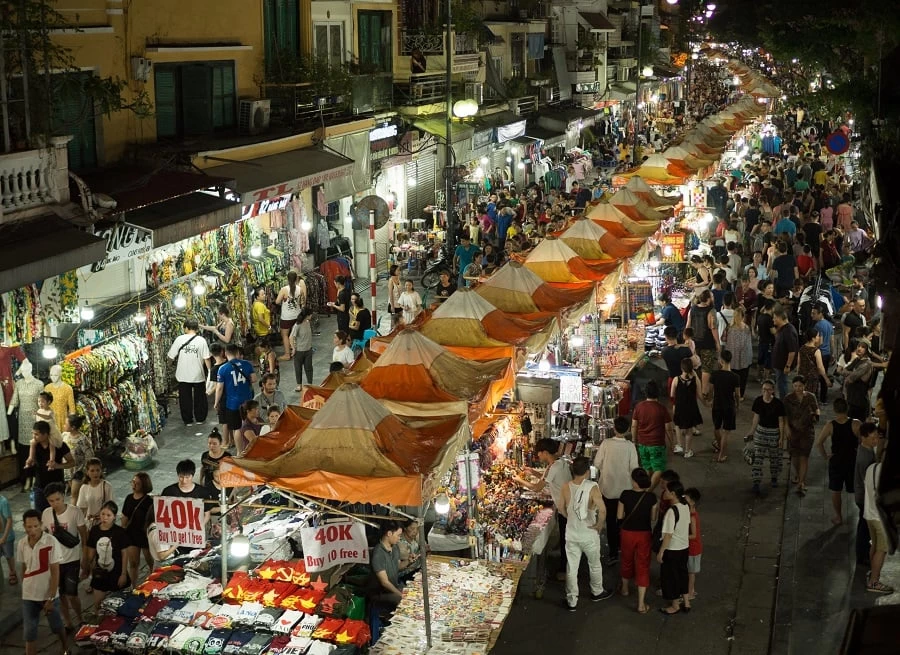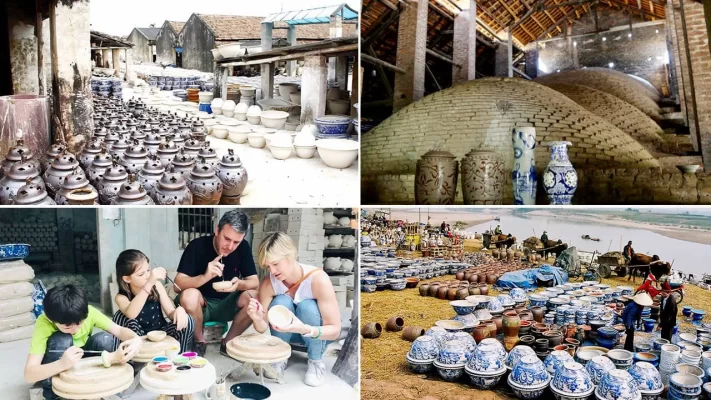
Let’s explore what’s interesting about Bat Trang pottery village!
Discover the charm of Bat Trang Pottery Village, a traditional Vietnamese craft village. Renowned for its exquisite ceramics and ancient crafting techniques, Bat Trang offers visitors a unique opportunity to explore time-honored pottery-making processes, try their hand at crafting, and shop for beautiful handmade souvenirs. Plan your visit to Bat Trang Pottery Village with Ula Travel today and immerse yourself in the artistry of Vietnam’s renowned ceramic tradition.
I. Introduction to Bat Trang Pottery Village
1. Where is Bat Trang Pottery Village?
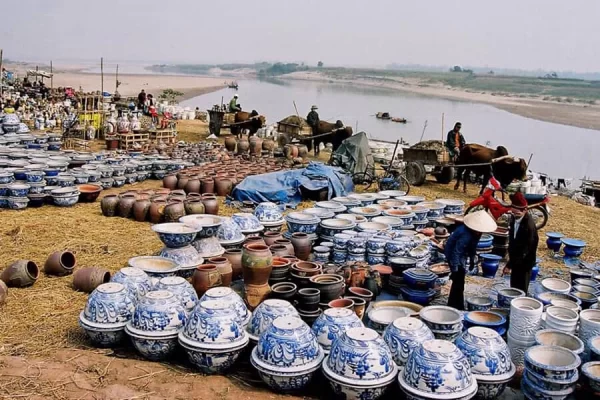
Bat Trang is an ancient pottery village on the Red River bank.
Bat Trang Pottery Village is located in Gia Lam District, Hanoi, approximately 13 kilometers (8 miles) from the city center. Easily accessible from Hanoi, the village offers a short and scenic drive, making it a popular day-trip destination for both locals and international tourists. Its proximity to the capital allows visitors to explore traditional Vietnamese craftsmanship without venturing too far away from the bustling city.
2. Brief History of Bat Trang Pottery Village
Bat Trang Pottery Village boasts a rich history that dates back over 1,000 years. Established during the Ly Dynasty (1010–1225), the village has long been renowned for its high-quality ceramics and pottery. The craftsmanship of Bat Trang can be traced to ancient techniques, which have been passed down through generations of artisans.
Originally, the village’s pottery was used for practical purposes, such as cooking and storage. Over time, Bat Trang evolved into a significant hub for decorative and artistic ceramics, adapting its styles and techniques to meet the demands of both domestic and international markets. The traditional methods employed by the artisans, including hand-painting and intricate glazing, continue to be central to the village’s identity.
II. Highlights of Bat Trang Pottery Village
1. Handmade Ceramic Collection
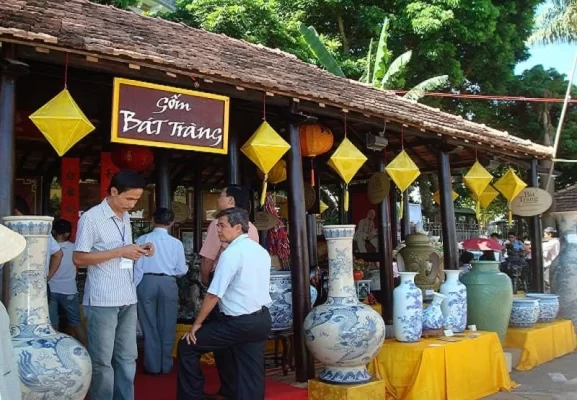
Bat Trang village has many collections of exquisite handmade ceramics.
Bat Trang Pottery Village is renowned for its exquisite collection of ceramics and pottery, which are celebrated for their craftsmanship and artistry. Key products include:
- Porcelain Vases and Jars: These are among the most sought-after items, known for their delicate designs and vibrant colors. The vases often feature traditional motifs such as floral patterns, dragons, and phoenixes, reflecting the rich cultural heritage of Vietnam.
- Ceramic Tableware: The village produces a wide range of tableware, including plates, bowls, and cups. These items are not only functional but also beautifully decorated with intricate patterns, making them popular both for everyday use and as decorative pieces.
- Decorative Tiles: Bat Trang Pottery Village is famous for its decorative tiles, which are used to adorn walls and floors. These tiles often come in traditional designs and can add a unique touch to any space.
- Hand-painted Pottery: This includes various items like teapots and vases that feature hand-painted designs. Each piece is unique and showcases the skills of the local artisans.
2. Advanced Ceramic Crafting Techniques
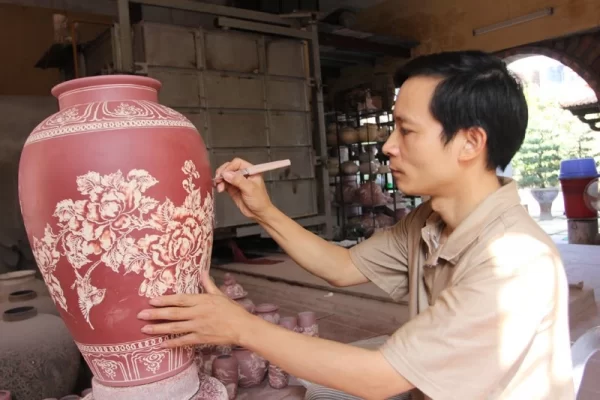
All patterns are hand painted.
The pottery and ceramics from Bat Trang are distinguished by their traditional crafting techniques, which have been passed down through generations:
- Clay Preparation: The process begins with the selection and preparation of high-quality clay. Artisans mix and knead the clay to achieve the desired consistency for shaping.
- Shaping: The clay is shaped into various forms using techniques such as wheel throwing or hand molding. Traditional methods are employed to ensure that each piece is both functional and aesthetically pleasing.
- Decoration: Once shaped, the pottery is meticulously decorated. This includes painting with traditional motifs and patterns or applying intricate designs using techniques like underglaze and overglaze painting.
- Firing: The decorated pottery is then fired in a kiln at high temperatures. This step is crucial, as it solidifies the clay and sets the glaze. The firing process also contributes to the final color and texture of the pottery.
- Glazing: The final step involves applying a glaze to give the pottery its glossy finish and enhance its durability. Different types of glazes are used to achieve various effects, from bright and vibrant to subtle and muted.
III. Experiences at Bat Trang Pottery Village
1. Explore the Ancient Bat Trang Village with Unique Architecture
When visiting Bat Trang Village in Gia Lam, you definitely cannot miss the ancient Bat Trang Village. Here, you’ll find many architectural structures intricately carved and adorned with antique charm. You’ll feel the aura of antiquity and sanctity as soon as you step in, admiring the houses nestled behind the lush green bamboo and reed groves.
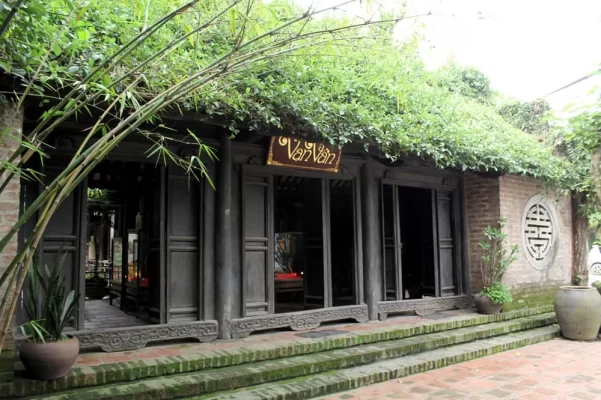
Van Van Ancient House
Whenever the wind blows, you can hear the rustling of leaves, making you feel more relaxed. Notable places you should visit include Van Van Ancient House and Bat Trang Village Communal House. This wooden house, over 200 years old, is an architectural masterpiece featuring ceramics, blue-glazed teapots, dragon vases, and stamped clay molds from before the 15th century.
The Bat Trang Village Communal House is a place of worship for the village’s guardian deity and also hosts lively festivals throughout the year. If you want to experience the unique, vibrant festival atmosphere, consider visiting Bat Trang Village in the early months of the year!
Click here: Hanoi Day Trip
2. Exploring the Pottery Workshops
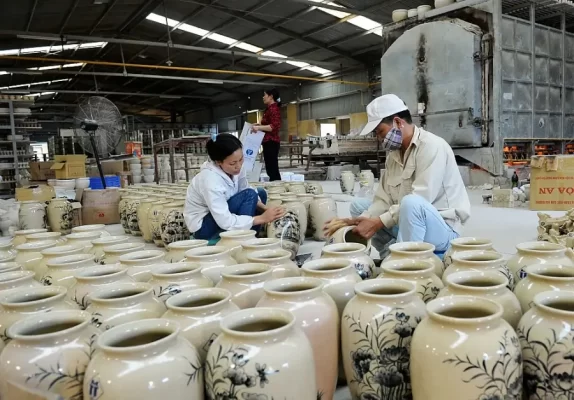
Working scene in a Bat Trang pottery workshop
Visitors to Bat Trang Pottery Village can enjoy a unique and immersive experience by exploring its traditional pottery workshops. The village is home to numerous workshops where traditional pottery is made. These workshops often offer guided tours where visitors can observe the entire pottery-making process.
You’ll see skilled artisans shaping clay on potter’s wheels, painting intricate designs, and firing the pottery in traditional kilns. Some workshops provide demonstrations of these techniques, giving you a deeper understanding of the craftsmanship involved.
3. Trying Pottery Making
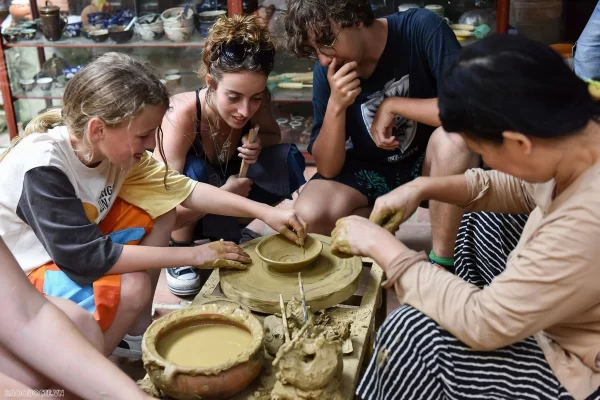
Tourists try making pottery at Bat Trang Village
For those interested in a hands-on experience, Bat Trang offers opportunities to try pottery making yourself:
- Pottery Workshops for Visitors: Many of the pottery workshops in Bat Trang provide interactive sessions where visitors can try their hand at making pottery. Under the guidance of experienced artisans, you can learn the basics of shaping clay, using a potter’s wheel, and decorating your creations.
- Creating Your Own Pottery: During these sessions, you’ll have the chance to create your own pottery items, such as bowls, cups, or vases. These experiences are designed to be beginner-friendly and offer a fun way to engage with the traditional craft. Once you’ve finished your piece, some workshops offer the option to have it fired and glazed, so you can take home a unique souvenir of your experience.
4. Bat Trang Ceramic Museum

Bat Trang Ceramic Museum
The Bat Trang Ceramic Museum is a fascinating destination that showcases the rich history and artistry of Vietnamese ceramics. This museum offers a comprehensive collection of pottery and porcelain pieces that span centuries, highlighting the evolution of local craftsmanship.
Visitors can explore traditional techniques, admire historical artifacts, and gain insight into the cultural significance of Bat Trang’s pottery. The museum also features interactive exhibits where guests can learn about the pottery-making process and view demonstrations by skilled artisans.
- Address: No. 28, Village 5, Bat Trang, Gia Lam, Hanoi
- Opening Hours: Daily from 8:00 a.m. to 5:30 p.m.
Entrance Fee:
- Entrance fee: 50,000 VND per person.
- Pottery-making experience: 70,000 VND/adult, 50,000 VND/child
- Enjoy tea and admire the works at Huong Sa Art House Tea Zen. 40,000 VND/person
5. Bat Trang Pottery Market
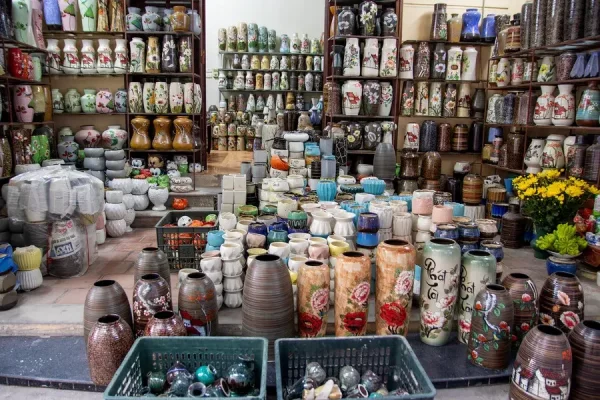
Bat Trang Pottery Market
The Bat Trang Pottery Market is a vibrant and bustling area where visitors can immerse themselves in the local ceramic culture. The market features a wide range of pottery products, including traditional items such as vases, bowls, and tea sets, as well as contemporary designs.
You can interact with local artisans, who are often present at their stalls, showcasing their craftsmanship and offering custom pieces. The market is a perfect place to pick up unique souvenirs and gifts, as well as to observe the dynamic atmosphere of Bat Trang’s pottery production.
Learn more about: Hanoi Attractions
IV. How to Get to Bat Trang Pottery Village from Hanoi
1. By Taxi
Taking a taxi is one of the most convenient and comfortable ways to reach Bat Trang Pottery Village. Taxis are readily available throughout Hanoi, and many drivers are familiar with the route to Bat Trang.
- Duration: The journey typically takes around 30 to 45 minutes, depending on traffic conditions.
- Cost: Expect to pay between $15 and $25 for a one-way trip, though prices may vary based on the taxi service and current traffic conditions.
2. By Bus
Several public buses travel from Hanoi to Bat Trang. The most common routes include Bus No. 47, which goes from Hanoi’s Long Bien Bus Station to Bat Trang.
- Duration: The bus ride usually takes about 45 to 60 minutes.
- Cost: The fare is quite affordable, typically around $1 to $2 per person.
3. By Motorbike
Renting a motorbike is a popular choice for those who prefer flexibility and adventure. Many rental shops in Hanoi offer motorbikes for rent, and the route to Bat Trang is relatively straightforward.
- Duration: The drive generally takes around 30 to 40 minutes.
- Cost: Rental fees for a motorbike usually range from $5 to $10 per day. Fuel costs are additional.
V. Best Time to Visit Bat Trang Pottery Village
1. Best Time to Visit
The ideal time to visit Bat Trang Pottery Village is during the dry season, which typically spans from November to April. During this period, the weather is mild and pleasant, making it comfortable to explore the village and its attractions.
Avoid visiting from May to October, which is the rainy season in Vietnam. During these months, Bat Trang experiences frequent showers and high humidity, making travel less enjoyable and potentially disrupting planned activities.
2. Visit during the Bat Trang Pottery Village Festival

Bat Trang Pottery Village Festival
The Bat Trang Pottery Village Festival is a vibrant celebration of traditional Vietnamese craftsmanship and culture held annually in Bat Trang Village. This festival provides a unique opportunity for visitors to immerse themselves in the rich heritage of Bat Trang, a village famous for its exquisite pottery and ceramics. During the festival, the village comes alive with a range of activities showcasing the skills of local artisans.
The festival is a journey that takes visitors back to the traditional cultural beauty of the thousand-year-old village, which is ancient and sacred and famous for its unique ceramic craft. From massive architectural works to unique intangible cultural values, the festival is an opportunity to enjoy and explore the special cultural and historical values of Bat Trang.
VI. Tips for Visiting Bat Trang Pottery Village
1. Local Rules and Customs
- Respect Local Traditions: Bat Trang Pottery Village is deeply rooted in traditional Vietnamese craftsmanship. When visiting, it’s important to show respect for the artisans and their work. Avoid touching or handling items without permission, especially those on display in workshops or galleries.
- Be Mindful of Photography: Always ask for permission before taking photos, especially in private workshops or of individuals. Some artisans might be working on intricate pieces and prefer not to be photographed. Respect their wishes to maintain a courteous interaction.
- Bargaining Etiquette: Bargaining is a common practice in Vietnamese markets, including Bat Trang. However, do it respectfully. Start with a reasonable offer, and negotiate politely. Remember that fair pricing is essential to supporting local artisans.
- Waste Management: Help in keeping the village clean by disposing of trash properly. Avoid littering, as maintaining cleanliness is crucial for preserving the village’s charm and environmental health.
2. Shopping Tips
- Understand the Product: Before purchasing, familiarize yourself with the different types of ceramics produced in Bat Trang. These include traditional blue-and-white porcelain, colorful glazed items, and contemporary designs. Knowing what you want will help you make informed decisions.
- Compare Prices: Prices can vary between shops and stalls. It’s wise to compare prices and quality before making a purchase. Don’t hesitate to visit multiple vendors to find the best deals and unique pieces.
- Check for Quality: Inspect the pottery for any defects such as cracks, chips, or uneven glazing. Authentic Bat Trang pottery should have a smooth finish and well-defined patterns. Ask the seller for details about the craftsmanship to ensure you’re getting a genuine product.
- Ask About Shipping: If you’re buying large or fragile items, inquire about shipping options. Many shops offer international shipping, but it’s best to confirm the costs and procedures to avoid surprises.
- Negotiate Wisely: As mentioned earlier, bargaining is common. Start by offering about 50% of the asking price and negotiating from there. Sellers usually expect some negotiation, so approach it as a friendly exchange rather than a confrontation.
- Learn Basic Vietnamese Phrases: Knowing a few basic phrases in Vietnamese can enhance your shopping experience. Simple greetings and polite expressions can go a long way in making a positive impression and building rapport with sellers.
- Verify Return Policies: Check the store’s return policy before making a purchase. This is particularly important for higher-value items or those that may not survive international shipping without damage.
VI. Frequently Asked Questions
1. How much is the entrance fee to Bat Trang Pottery Village?
The entrance to Bat Trang Pottery Village is typically free of charge. However, some specific workshops or private tours may have a fee. It’s best to check in advance with local tour operators or the workshop you plan to visit to confirm any potential costs. Additionally, there might be small fees for certain activities, such as pottery-making workshops or guided tours.
2. Do I need to make a reservation before visiting?
Generally, you do not need to make a reservation to visit Bat Trang Pottery Village. The village is open to visitors throughout the day without prior booking. However, if you are interested in participating in a pottery-making workshop or a guided tour, it is advisable to make a reservation in advance to ensure availability. This is especially recommended during peak tourist seasons or if you are traveling with a large group.
3. What are the opening hours of the pottery workshops?
The pottery workshops in Bat Trang typically open from 8:00 a.m. to 6:00 p.m. daily. Most workshops follow these standard hours, but it is always a good idea to check the specific opening times of the workshops you plan to visit, as hours may vary slightly. Some workshops may also have extended hours or close earlier on certain days, so confirming in advance can help you plan your visit more effectively.
In summary, Bat Trang Pottery Village is a captivating destination offering a deep dive into Vietnam’s ceramic traditions. Located near Hanoi, it provides a unique opportunity to explore traditional craftsmanship, participate in pottery-making workshops, and purchase beautifully crafted souvenirs. This charming village combines historical significance with practical experiences, making it a must-visit for anyone interested in Vietnamese culture and artistry. Whether you’re looking for a cultural adventure or a memorable day trip, Bat Trang promises to leave you with both stunning mementos and enriching experiences.
See more: Hanoi Travel Tips







